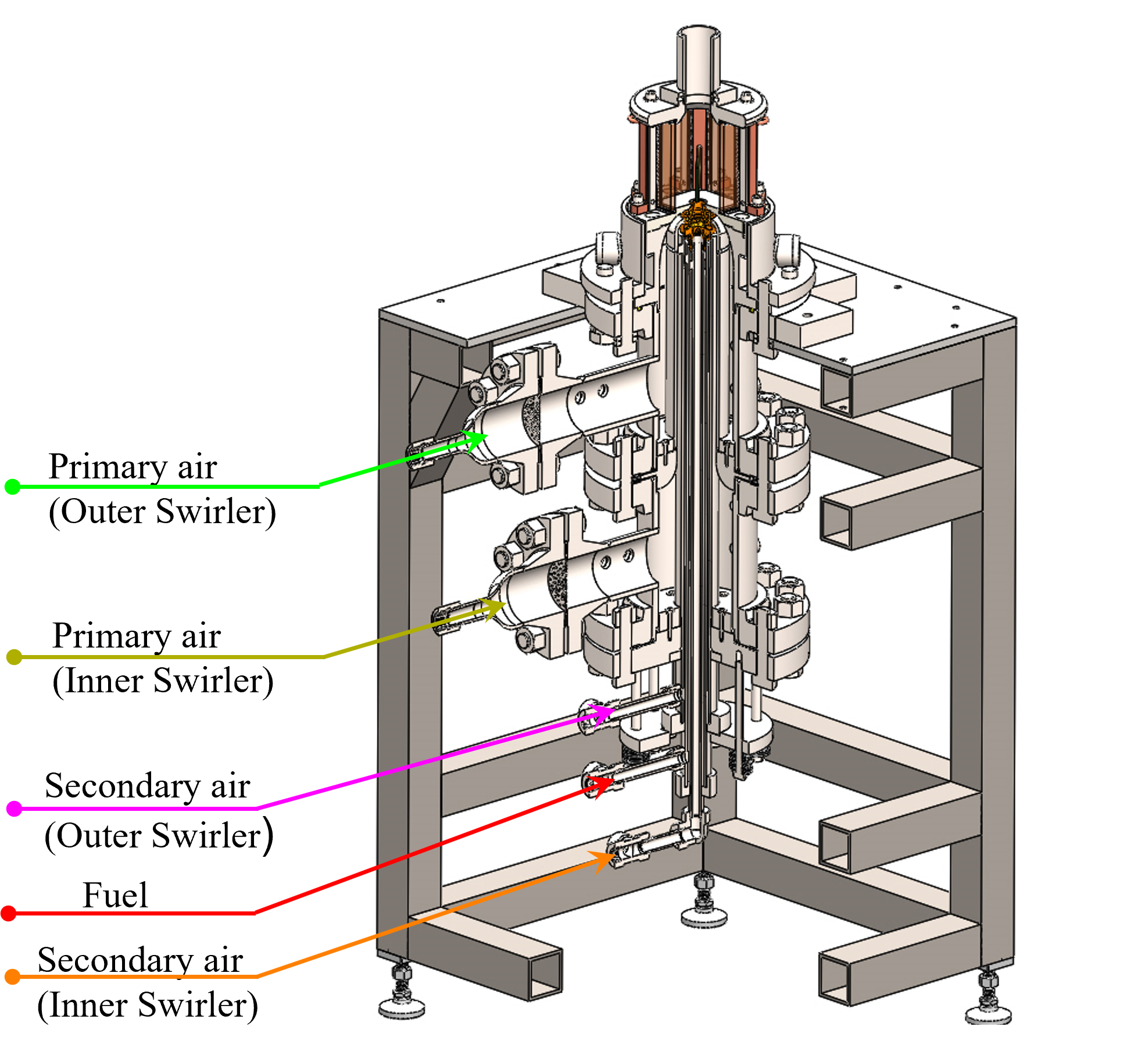Introduction
Lean combustion has been the focus of most gas turbine combustion research over the last century. Its benefits with respect to reduced NOx content in the turbine’s emissions has led to its widespread usage in both commercial power generation and the aviation sectors. However, these lean flames are susceptible to combustion instabilities such as flame extinction, re-ignition and thermoacoustic instabilities. In addition, introducing the air/fuel mixture into the combustion chamber with a swirl has been proven to stabilize the flames.
Although compact in nature, these swirling flames are characterized by complex interactions between flame dynamics, thermoacoustics, sheared swirling flows and high-intensity turbulence. Understanding the coupling between the thermoacoustic instabilities and its relation to hydrodynamic instabilities is imperative to designing highly efficient and stable combustors.
Description of the DISCo Facility
The design of the Dual Independent Swirl Combustor facility is based on the following main goals: a) the ability to control the outer to inner swirler air split ratio (R); b) the ability to control the swirl number of the inner (Si) and outer swirler (So).
DISCo is designed to operate at atmospheric conditions for mass flow rates up to 12 g/s and equivalence ratios between 0.6-1.2. Solid metal plates or quartz windows can be used to provide wall surface instrumentation/optical access from all four sides of the combustion chamber. In addition, the water cooled copper posts are instrumented with high-temperature microphones. Long runtimes are achieved through actively cooling the combustion chamber through a closed water circuit.
The novelty of the dual swirler used in DISCo lies in the addition of axial air injectors in each of inner and outer swirlers to alter the swirl number (S). The swirler is fed by a total of five plenums corresponding to the five fluid paths described below. These are letter labeled in Figure 2 as A: Outer Swirler, B: Inner Swirler, C: Secondary Air (Inner swirler), D: Secondary Air (Outer swirler) and E: Fuel. The swirler feeds the partially premixed fuel-air mixture into the combustion chamber. The mass-flow rate through the five fluid paths can be manipulated independently, which results in the manipulation of R, Si and So in real time.


Multi-disciplinary aspects
Combustion physics
Understanding the coupling between the thermoacoustic instabilities in the combustor and its relation to hydrodynamic instabilities is imperative to designing highly efficient and stable combustors. In this front, we use optical diagnostic techniques such as particle image velocimetry, chemiluminescence.
Although there are numerous studies of swirl combustors at different equivalence ratios on the interaction of the instabilities mentioned above and corresponding flow field characterization, there has not yet been a detailed investigation of the effects of variation in R, Si, and So using high speed optical measurements. We plan to vary these parameters in real time and understand the complex interaction that occurs between the flame, vortices, and the shear layer.
The video below is a sample of the high speed PIV measurements obtained from DISCo at a total mass flow rate of 8g/s ,Φ=0.8 and R=1.6. It showcases the highly unstable shear layer dynamics observed in the combustion chamber.
To understand the coupling between flame and pressure fluctuations in combustion chamber, we use chemiluminescence measurements. In the video below, CH* is observed in the combustion chamber which acts as a flame tracker. Additionally, simultaneous pressure measurements taken in the combustion chamber reveal the strong coupling between the flame and the pressure fluctuations.
Adaptive control
Active control techniques have been used to reduce these instabilities. However, open-loop controllers have a limited operational range, and closed-loop controllers usually require high-bandwidth actuators. The present work considers adaptive control, where the feedback control law operates with a low bandwidth relative to the open-loop dynamics of the combustor, and adapts to a wide range of operating points. An adaptive digital controller based on retrospective cost adaptive control is applied to DISCo with the primary objective of reducing the amplitude of the combustion instabilities.
The results of several tests performed on the model combustor which demonstrate the effectiveness of the adaptive controller can be found in the publication listed below.
Validation of reduced order CFD models
We plan to use DISCo as a model gas turbine combustor by developing a database of the PIV based flow fields and pressure traces of combustor at different operating conditions to validate reduced order CFD models.
Publications
Rahul Ramesh, Sanjar Obidov, Juan Paredes, Dennis S. Bernstein and Mirko Gamba. “Design and Characterization of the Dual Independent Swirl Combustor Facility (DISCo).” AIAA Propulsion and Energy 2021 Forum.
Juan A. Paredes, Rahul Ramesh, Sanjar Obidov, Mirko Gamba and Dennis Bernstein. “Experimental Investigation of Adaptive Feedback Control on a Dual-Swirl-Stabilized Gas Turbine Model Combustor.” AIAA SCITECH 2022 Forum.
Rahul Ramesh and Mirko Gamba. “Influence of Air Split Ratio Effects on Combustion Instabilities in a Dual-Swirl Gas Turbine Model Combustor using Cinematographic PIV and Chemiluminescence Imaging.” 20th International Symposium on Application of Laser and Imaging Techniques to Fluid Mechanics, July 2022.
